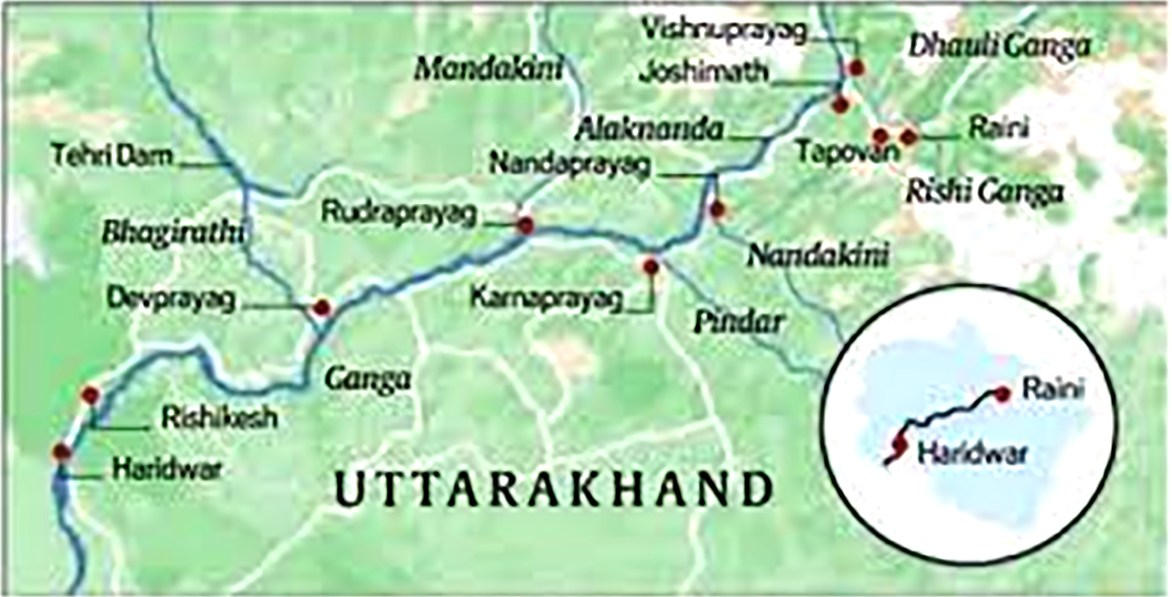Uttarakhand Switch to Hindi
Environmental Crisis Over the Rivers in Uttarakhand
Why in News?
Uttarakhand, known for its pristine rivers and streams, is facing an unprecedented environmental crisis.
- Changing weather patterns, climate change, and increasing human activities are pushing the state’s 206 perennial rivers and streams toward the brink of drying up.
Key Points
- Current Situation:
- According to a report by the Spring and Rejuvenation Authority (SARA), a staggering 5,428 water sources in Uttarakhand are currently under threat.
- Climate change experts at SARA, highlighted that human intervention, rather than natural causes, is primarily responsible for the degradation of these water bodies.
- Establishment of SARA:
- In response to this crisis, the Uttarakhand government established SARA to investigate the state of its perennial rivers and streams.
- This initiative aims to understand the impacts of climate change on these vital water sources.
- SARA recommended all relevant state departments to collaborate and provide data on the condition of these water bodies. The findings have raised serious concerns within the government, prompting the need for urgent interventions.
- In response to this crisis, the Uttarakhand government established SARA to investigate the state of its perennial rivers and streams.
- Pilot Projects for River Rejuvenation:
- SARA has prepared a pilot project to revive five key rivers:
- The Song River in Dehradun, the Western Nayar and Eastern Nayar in Pauri, the Shipra River in Nainital, and the Gaudi River in Champawat.
- The National Institute of Hydrology (NIH) and IIT Roorkee have been assigned to study these rivers, with plans to extend the project to other rivers based on the findings.
- SARA has prepared a pilot project to revive five key rivers:
- Impact of Climate Change:
- The rise in temperature due to climate change has been more pronounced in Tibet and the Himalayas than in the rest of the world over the past 150 years.
- This alarming trend is leading to significant environmental consequences, including the drying up of water sources.
- Data from the Water Resources Department reveals that 288 water sources in the state have less than 50% of their original water levels remaining, with nearly 50 sources having less than 75% of their water left.
- Related Observations & Impact:
- Environmentalists and local officials have observed drastic changes in water levels and river courses.
- In Bhimtal, the lake has started to resemble a plain, and similar crises are emerging across other rivers and water sources.
- Climate scientists warn that climate change is causing mountains to crumble and rivers to either change their courses or wreak havoc during floods.
- In Haldwani, the water levels of the Gaula and Kosi rivers have dropped, creating a crisis for drinking water and irrigation.
Uttarakhand Switch to Hindi
Uttarakhand's Grassland Conservation SOP
Why in News?
The forest department of Uttarakhand government will prepare a standard operating procedure (SOP) to conserve grasslands in the Upper Himalayan Region of the state.
- This initiative aims to address the increasing frequency of landslides and land subsidence caused by both natural and human activities.
Key Points
- Grassland Conservation Initiatives:
- Dayara Bugyal, a sensitive ecological area, has shown positive results from previous ecological restoration efforts. To extend these benefits to other grasslands, the forest department plans to develop a SOP for conservation.
- This SOP will focus on reducing biological pressure and preventing further degradation.
- So far, conservation work has been carried out on approximately 83 hectares of land across 22 grasslands under the Bugyal Conservation Scheme.
- Dayara Bugyal, a sensitive ecological area, has shown positive results from previous ecological restoration efforts. To extend these benefits to other grasslands, the forest department plans to develop a SOP for conservation.
- Snow Leopard Conservation Center:
- During their visit, the officials also inspected a snow leopard conservation center under construction at Lanka near Gangotri.
- The center is expected to be ready within a year, offering tourists an opportunity to experience the natural environment and observe snow leopards in their habitat.
- Gangotri National Park has emerged as a significant trans-Himalayan national park over the past decade.
- The Wildlife Institute of India has recorded a substantial presence of snow leopards in the park, which was relatively unknown until recently.
- During their visit, the officials also inspected a snow leopard conservation center under construction at Lanka near Gangotri.




%20MPPCS%202025%20Desktop%20E.jpg)
%20MPPCS%202025%20Mobile%20E%20(1).jpg)










.png)
.png)











 PCS Parikshan
PCS Parikshan


